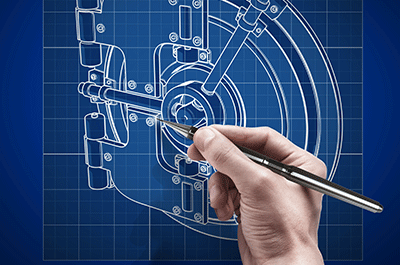Tip 1: Create Drawings Standards, & Stick To Them!
Produce a thorough checklist of what you need on each type of drawing. Creating a checklist will reduce the amount of errors which could be made in the design process. Print off a collection of your drawings to help create a list of steps and things you will need for that type of drawing.
Then, fill out all the general information you need, such as how you fill out your title block, basic annotations for each sheet, notes, details, etc.
Our handy checklist can also help you understand what to look out for when creating CAD drawings:
- All drawings should be created to British Standard 8888
- Avoid double dimensioning i.e. dimensioning the same feature in two ways on the same drawing
- Do not dimension to hidden lines, use sections and dimension to solid lines
- Use cross hair centre marks on holes to dimension too – not just a line going perhaps somewhere near.
- Don’t dimension on the part – place dimensions away from the part
- Neatly stagger stacked dimensions
- Be consistent – especially with text font and sizes on tolerances and dimensions
- When sectioning views use a clear hatch type and scale – often hatching can confuse features, such as holes, if badly selected.
- Datums – carefully select and be consistent.
- Avoid sequential dimensioning as this will cause tolerance build up
- Tolerances – unnecessarily tight and the cost of manufacture increases – too slack and the part may not fit / perform its intended function.
Tip 2: Show Off Features With Images
The more complicated the drawing, the harder it can be for others to understand. Use images, symbols and numbers to explain the features of your product part that may not be clear to others. You can use different angles and views to show off that feature.

Tip 3: Conduct Quality Checks
Print out your drawings and go through your checklist thoroughly ensuring you mark anything that’s wrong. If you are missing information, write, sketch or draw it in. As long as the items you found missing get on to your drawing, everything should be fine. Once you have completed your first check and amended your errors, repeat the process until you are happy for it to be checked by another person.
Questions to ask yourself:
- Can I make this?
- Do I understand the shape?
- Is there enough information for manufacturers e.g. dimensions, finish, material, etc.
- On assembly drawings – can I find every part in the parts list which makes this assembly?
- Do I have parts left over that are not shown on the assembly drawing?
Designing For Extrusion?
We've put together articles to help provide guidance and assistance for those who are designing for extrusion, check them out for more tips and tricks;
How We Can Help
If you require design assistance, get in touch with our in-house product designer here. If you have a drawing you would like a 3D print of, you can upload your drawing here or use the button below to order your free 3d printed prototype.
.png?width=1800&height=700&name=Untitled%20(49).png)
.png?width=150&height=70&name=BWC%20Logo%20(Custom).png)
